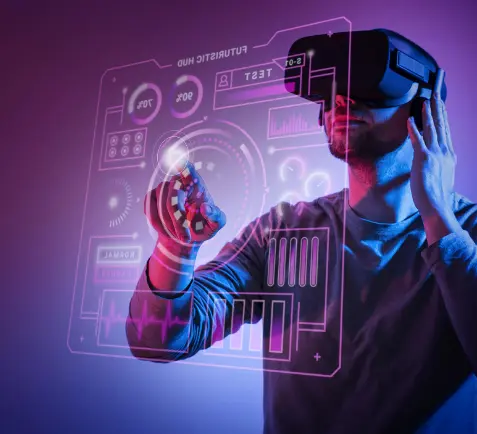Imagine a world where every learner has access to a one-of-a-kind educational journey, meticulously designed to unlock their full potential. That’s the promise of personalized edtech solutions. In this article, we will delve deep into the world of personalized edtech, exploring the groundbreaking techniques and tools shaping the future of education.
The dawn of the digital age has brought forth a wealth of opportunities to revolutionize the way we learn, and at the heart of this transformation lies personalized education. By leveraging advanced educational technologies (edtech), it is now possible to create highly customized and engaging learning experiences tailored to the unique needs, preferences, and goals of each student.
Impact of AI and Machine Learning on Personalization in Education
AI and machine learning are revolutionizing the edtech landscape, enabling the creation of highly personalized learning experiences. Here are some ways these technologies are making a difference:
- Personalized content recommendations: AI-driven algorithms can analyze students’ learning history, preferences, and performance to suggest tailored content that caters to their needs. For example, a study by the Center for Digital Education found that 94% of educators reported an increase in student engagement when using AI-based content recommendations.
- Intelligent tutoring systems: These systems use AI to provide real-time, personalized feedback and guidance to students. According to a report from eSchool News, students using intelligent tutoring systems experienced a 78% improvement in their learning outcomes compared to traditional methods.
- Predictive analytics: Machine learning algorithms can analyze large datasets to identify patterns and predict future student performance. This helps educators intervene early and address potential issues before they become major problems.
Read how we built a comprehensive learning platform for Edureka!
Adaptive Learning Technologies: Customizing Educational Content
Adaptive learning technologies are a key component of personalized edtech solutions. They use data-driven approaches to tailor educational content to each student’s needs. Here’s how they work:
- Assessing students’ knowledge: Adaptive learning systems often begin by gauging students’ existing knowledge and skill levels through pre-assessments.
- Customizing learning pathways: Based on the assessment results, the system creates personalized learning pathways for each student, adjusting the difficulty level, pace, and content to match their needs.
- Ongoing adjustments: As students progress, the system continuously monitors their performance and adjusts the learning pathway accordingly.
A 2018 study conducted by the Bill & Melinda Gates Foundation found that students using adaptive learning platforms demonstrated an 11% improvement in math scores and a 9% improvement in reading scores compared to their peers using traditional methods.
Learning Analytics: Tracking and Assessing Student Progress
Learning analytics refers to the process of collecting, measuring, analyzing, and reporting data about students’ learning experiences. These insights can help educators make informed decisions to improve teaching methods and personalize the learning process. Key benefits:
- Identifying at-risk students: By analyzing patterns in student performance, learning analytics can help educators identify students who may be struggling and provide timely intervention. A study by the American Institutes for Research found that learning analytics can help reduce dropout rates by up to 15%.
- Personalized feedback: Learning analytics enables the provision of personalized feedback based on each student’s strengths and weaknesses, leading to more effective learning outcomes. A report from the Alliance for Excellent Education found that personalized feedback can improve student achievement by 30%.
- Continuous improvement: By monitoring student performance data over time, educators can identify trends and areas for improvement, leading to more effective teaching strategies.
Gamification and Immersive Learning Experiences
Gamification and immersive learning experiences are innovative edtech approaches that aim to increase student engagement and motivation. Some key aspects include:
- Incorporating game design elements into the learning process, such as point systems, leaderboards, and badges. “A 2019 study from the University of Hong Kong found that gamification can increase student motivation by up to 60%”
- Technologies like Virtual Reality (VR) and Augmented Reality (AR) create immersive learning environments, allowing students to explore and interact with educational content in a more engaging way. A 2020 meta-analysis published in the Journal of Educational Technology & Society found that VR and AR-based learning experiences led to a 22% increase in student performance compared to traditional methods.
Enhancing Educator Experience through Smart Classroom Tools
Smart classroom tools aim to improve the teaching experience by simplifying administrative tasks, facilitating communication, and providing access to valuable insights. Some key benefits include:
- Time-saving tools: Platforms that automate tasks such as grading, attendance tracking, and lesson planning can save educators valuable time, allowing them to focus more on teaching and student support. A 2017 survey by Educators 4 Excellence found that teachers spend an average of 7 hours per week on administrative tasks. Smart classroom tools can help reduce this burden.
- Improved communication: Tools like learning management systems and parent-teacher communication apps streamline the flow of information between educators, students, and parents, leading to better collaboration and support.
- Data-driven decision-making: By providing real-time data on student performance and engagement, smart classroom tools empower educators to make informed decisions that improve the learning experience.
Learn how Mantra Labs built Dynamic Role-based System for Kreedo (SaaS-based School & Learning Management System)
Personalized Professional Development for Educators
Just as personalized edtech solutions benefit students, they can also enhance the professional development experience for educators. Key aspects of personalized professional development include:
- Customized learning pathways: Tailoring professional development opportunities to match each educator’s unique needs, interests, and skill levels. A 2016 report from the Learning Policy Institute found that personalized professional development can lead to a 49% increase in teacher retention rates.
- On-demand resources: Offering flexible access to professional development materials, including online courses, webinars, and coaching, which allows educators to learn at their own pace and on their own schedule.
- Collaborative learning: Facilitating connections between educators to share best practices, resources, and support through online communities, discussion boards, and social media platforms.
Barriers to Implementation and Addressing Concerns
Despite the potential benefits of personalized edtech solutions, there are several barriers to widespread adoption:
- Limited resources: Implementing personalized edtech solutions can require significant financial investment, which may not be feasible for all schools and districts. Grants and partnerships with edtech companies can help alleviate some of these costs.
- Resistance to change: Educators may be hesitant to adopt new technologies due to concerns about increased workload or a perceived lack of effectiveness. Providing ongoing training and support can help address these concerns.
- Data privacy and security: The use of student data in personalized edtech solutions raises concerns about privacy and security. Ensuring compliance with data protection regulations and adopting best practices for data management can help mitigate these risks.
Success Stories: Case Studies of Personalized Edtech in Practice
Summit Public Schools: This network of charter schools in the United States uses a personalized learning platform that combines self-directed learning, teacher-led instruction, and real-world projects.
“According to a 2017 study by the RAND Corporation, Summit students achieved 3.6 times more growth in math and 2.5 times more growth in reading compared to their peers in traditional schools”
New Classrooms: This nonprofit organization developed a personalized learning model called Teach to One: Math, which utilizes a combination of teacher-led instruction, collaborative learning, and online activities.
“An evaluation by the Center for Reinventing Public Education found that students using Teach to One: Math experienced 1.5 times more growth in math achievement compared to the national average”
The Future of Personalized Edtech: Emerging Trends and Predictions
As technology continues to advance, personalized edtech solutions are expected to become even more sophisticated and effective. Some emerging trends and predictions include:
- Greater integration of AI and machine learning: As these technologies become more advanced, they will play an increasingly significant role in creating highly personalized learning experiences.
- Increased use of immersive technologies: Virtual Reality (VR) and Augmented Reality (AR) will become more widespread, offering new opportunities for interactive, immersive learning experiences.
- Focus on social-emotional learning: Personalized edtech solutions will increasingly incorporate social-emotional learning components, helping students develop key interpersonal and emotional skills.
Knowledge thats worth delivered in your inbox







